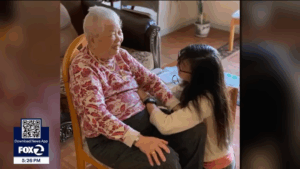The death of a loved neighborhood cat is prompting a new push to regulate the ever-expanding robo-taxi industry. So last week we told you about Kit Kat, who was hit and killed by…
Here in San Francisco, the planning is underway for the future of one of Union Square’s most iconic buildings. Our Kelsey Thorne shows us what could be next for Macy’s flagship store.…
New at 5, the man accused of fatally beating an 88-year-old woman known as Grandma Wong in San Francisco back in 2019 has now been found guilty. KTVU’s Christian Captain joins us…

In a shocking turn of events, an 18-year-old man from Queens, New York, has turned himself in following a shooting incident at the Marina Dining Hall of the University of Bridgeport. This tragic event not only raised concerns about campus safety but also sparked discussions about the underlying issues that can lead to such violent episodes among young individuals. Let’s delve into this incident to understand its implications and the community’s response.
## The Incident Unfolded
On the evening of October 29, around 6:30 p.m., chaos erupted at the University of Bridgeport when gunfire rang out in the Marina Dining Hall. Alarmed patrons sought safety as panic filled the room. In the aftermath, one victim was injured, sustaining a gunshot wound to the arm and a graze wound to the chest. Thankfully, the injuries have been deemed non-life-threatening, but this incident has left lasting repercussions for the university community.
## The Suspect in Custody
Fast forward to Friday, the suspect, identified as an 18-year-old male, willingly turned himself in to law enforcement. He faced serious charges, including first-degree assault with a firearm. His arraignment at Bridgeport Superior Court brings attention to the judicial process that follows such violent actions. The court’s role in addressing youth violence is crucial as it not only serves justice but also sets a precedent for deterrence among peers.
## The Motive Behind the Violence
Investigators have suggested that the shooting stemmed from a personal conflict related to a romantic relationship. This raises a critical issue: emotional turmoil among teenagers can lead to rash decisions driven by anger and jealousy. It’s essential to explore how relationships among young individuals can quickly escalate to violence and what preventive measures can be put in place to avoid future occurrences.
## Community Response
The shooting prompted a swift reaction from the university’s administration. In a bid to ensure the safety of students and faculty, the campus was placed on lockdown for several hours as police worked to secure the scene and gather evidence. The alarm and fear felt by many highlight the pressing need for increased security measures in educational institutions. The university community now finds itself navigating this traumatic event, seeking ways to heal and restore a sense of normalcy.
## Lessons Learned and Moving Forward
As educators, parents, and community members, the time has come to reflect on the lessons learned from this tragic incident. How can we foster open communication among teens to address their issues without resorting to violence? What resources are available to help young people navigate their emotions and relationships? This incident serves as a grim reminder that we must work collaboratively to build supportive environments that prioritize mental health and conflict resolution.
## Conclusion
The shooting at the University of Bridgeport not only shocked a community but also illuminated crucial issues that transcend the university gates. As discussions around youth violence, personal conflicts, and mental health continue, it is imperative for all stakeholders to engage actively in creating solutions. By coming together to foster understanding and build stronger support systems, we can hope to prevent future incidents and create a safer, more compassionate environment for all.

In the bustling world of fine dining, securing a reservation at a coveted restaurant has always been a challenge. The laws of supply and demand dictate that popular spots are often fully booked, leaving food enthusiasts frustrated. As Scarsdale foodie Mark Hauser points out, “the Manhattan hotspots now that you really want to get a reservation – like Atomix – it’s really hard unless you know somebody.” But it’s not just foodies facing this dilemma; a new player has entered the scene—bots. In this blog post, we’ll explore the evolving landscape of restaurant reservations, the impact of technology, and the recent legislative changes aimed at leveling the playing field.
## Chapter 1: The Reservation Challenge
The struggle for a table at a popular restaurant has become increasingly competitive. Over the past two years, many restaurants have reported a significant increase in no-shows, with numbers soaring from the usual 5-10% to alarming rates of 20-25%. Amy Zhou, the managing director of operations at Gracious Hospitality Management, which oversees establishments like COTE Korean Steakhouse, has witnessed this trend firsthand. “Bad actors would program bots that had the ability to understand when my reservations systems were going to release every single reservation online and they would take every single one of them,” Zhou explains.
This surge in automated reservation-taking not only frustrates diners but also poses a serious threat to the restaurant industry. Mario Fava, owner of Moscato in Scarsdale, emphasizes the financial strain: “Especially having a small restaurant, if you don’t fill a table, that hurts the bottom line at the end of the day.”
## Chapter 2: The Impact of No-Shows
The ramifications of increased no-shows extend beyond just the empty tables. Restaurants like COTE, which offers around 400 reservations nightly, face significant operational challenges. Zhou highlights, “All of a sudden, one hundred covers don’t show up, that’s— on any given night— three servers, a bartender, three server assistants. Food runners. That’s up to ten to twelve staff who are not making the income they were expecting to make for an evening. It’s really damaging.” This ripple effect can lead to diminished morale among staff and a decline in service quality, ultimately affecting the dining experience for patrons.
## Chapter 3: Legislative Solutions
In response to this ongoing crisis, a new state law in New York has been introduced to combat the predatory practices of unauthorized third-party reservation services. Governor Kathy Hochul stated, “We’re putting an end to the predatory black market for restaurant reservations — protecting consumers and businesses, and giving everyone a chance to get a seat at the dinner table.” This legislation aims to ensure that diners have a fair chance at securing reservations without the interference of automated systems.
Andrew Rigie, executive director of the NYC Hospitality Alliance, is optimistic about the impact of this measure. “At least government can go after them, issue penalties and mitigate the impact,” he asserts. Importantly, this legislation targets unauthorized third-party companies, differentiating them from legitimate platforms like OpenTable and Resy, which maintain certified relationships with restaurants.
## Chapter 4: The Human Touch
While technology has transformed the way we dine, it’s clear that the human element remains essential in the reservation process. Regular diner Mike Wallace from Southport, CT, shares his secret to success: “I think if you’re persistent, it helps.” His experience underscores the importance of patience and resilience in securing a spot at popular eateries.
As the industry adapts to these changes, diners may find that the new legislation gives them a better shot at getting a reservation, allowing them to enjoy their favorite culinary experiences without the interference of bots.
## Conclusion: A New Era for Dining
The landscape of restaurant reservations is shifting, and with it comes hope for a more equitable dining experience. As New York’s new legislation takes effect, it aims to protect both consumers and businesses from the pitfalls of automated reservation systems. The future may hold a more balanced approach, where persistence and a personal touch can once again shine through in the quest for a table at the hottest spots. Whether you’re a dedicated foodie or a casual diner, the changes ahead promise to make dining out a more enjoyable and accessible experience for all.








